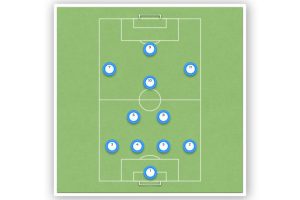The Evolution Of The Wide Midfielder Position In Soccer
Soccer is a game with constantly evolving tactics and strategies. One of the most important positions on the field is that of the wide midfielder, which has seen remarkable changes over time.
This article will explore the evolution of this position from its early days to modern-day soccer.
The role of the wide midfielder requires a player who can both defend and attack. In today’s game, they are often relied upon for their dribbling ability, crossing abilities, and offensive creativity as well as providing defensive coverage when needed.
It is an incredibly versatile position that continues to evolve in terms of technique and tactical awareness.
Early History Of The Wide Midfielder
The wide midfielder position in soccer has a long, rich history that goes back to the late 19th century. It was during this period when teams first began experimenting with different formations and strategies on how best to utilize players on the field.
One interesting statistic is that the modern day 4-3-3 formation, which is used by many of today’s top clubs, originated as far back as 1906.
Throughout its evolution, technique development and player analysis were two key components that allowed for the position to grow and become more refined over time. While there were many theories about how to play effectively from out wide, it wasn’t until later years that coaches really began to understand what made an effective wide midfielder successful.
This included elements such as defensive duties, dribbling ability and crossing accuracy – all skillsets required for any contemporary footballer in the role. As we move into the next section detailing modern day requirements for this versatile position, these early experiments are undoubtedly responsible for laying down much of the groundwork seen today.
Modern-Day Requirements
The wide midfielder position has evolved significantly over the years, and many of today’s requirements are much different than they were at its inception.
Speed is now essential for wide midfielders to be able to keep up with the pace of play in modern soccer. Alongside speed, fitness is also key for a wide midfielder as it allows them to stay on top of their game throughout an entire match.
In addition, technical abilities have become increasingly important for this position. Dribbling and crossing skills are paramount since these players often act as the connection between defense and attack. Passing accuracy is another skill that must be developed by contemporary wide midfielders; pin-point passing can create chances out of nowhere as well as open space for teammates to run into or score from distance.
These attributes have allowed the role of a wide midfielder to expand beyond simply defending, enabling them more offensive responsibilities such as running onto through balls and taking shots from range when opportunity arises.
With greater freedom comes increased pressure, however: wingers must always remain aware of potential counterattacks while still being ready to join in on offense whenever possible.
Offensive Responsibilities
The modern wide midfielder position in soccer is marked by immense creative freedom. Wide midfielders are afforded the opportunity to express their artistry and skill on the pitch, often playing a critical role in orchestrating an attack or creating chances for teammates. This requires excellent physical conditioning, as they must be able to sprint up and down the field while still possessing enough stamina to contribute offensively late into games.
To better understand the responsibilities of a wide midfielder, a table summarizing key aspects of this offensive duty can help provide clarity:
| Responsibilities | Technique | Example |
|---|---|---|
| Run onto through balls from other players (e.g., strikers) | Proper weight and accuracy of pass when receiving ball; acceleration towards goal after receiving ball | Get behind defenders using his speed with timely runs; keep possession of ball under pressure from defender until proper passing lane opens up for teammate |
| Crosses into box from wings | Creating angles so that cross can reach intended target; using aerial ability to win headers at far post if necessary | Deliver accurate crosses regularly throughout game; use either foot depending on situation for maximum effectiveness |
| Dribbling past defenders near touchline/wing area | Speed and agility along with good control over body movements when dribbling past defender(s) | Utilize feints, step-overs, quick changes in direction to get past opponents quickly; combine technique with pace to create dangerous attacking situations out wide against opponent’s defense |
It is clear that wide midfielders have significant offensive roles within teams’ tactics. They need to possess both technical proficiency as well as creativity in order to make split-second decisions on the field during matches in order to maximize their team’s potential going forward. With these abilities honed through practice, they become more than just passers – they become playmakers capable of changing entire games. Transitioning now into how wide midfielders also contribute defensively…
Defensive Responsibilities
Apart from their offensive duties, wide midfielders also have defensive responsibilities. The most common defensive tactic employed by a wide midfielder is man-marking an opposing player on the wing or covering for their fullback if they are caught out of position.
In addition, wide midfielders must be aware of their team’s overall defensive shape and make sure to check in with teammates when moving forward. Furthermore, they must be able to read situations quickly and adjust accordingly while providing support defensively.
Tactical awareness is critical aspect of defending as a wide midfielder. Knowing when to press high up the pitch and when to drop into deeper positions can help limit space for opponents and slow down attacks before they reach dangerous areas near goal.
Wide midfielders must also recognize opportunities to counter attack quickly by transitioning through different phases of play while making smart passes that create scoring chances for their forwards. Overall, tactical awareness plays a key role in the successful execution and implementation of a manager’s tactics during any given match.
Tactical Awareness
The wide midfielder position has evolved significantly over the years, and a key component of this evolution is tactical awareness. To be successful in the role, it’s essential that they understand how to transition quickly between attacking and defending roles as well as where on the pitch their team needs them most at any given moment.
This also includes understanding when to use crossing techniques – knowing when these are effective, who should take advantage of them, and where best to target the ball. A great example of an excellent tactically aware wide midfielder is Cristiano Ronaldo. He understands his own strengths and weaknesses, knows when he needs to drive forward or stay back, and can pick out areas for teammates with deadly precision using his expert crossing technique.
His ability to read the game so accurately makes him one of the greatest ever players in this position. All modern day wide midfielders must strive to develop similar levels of tactical awareness if they want to achieve success in their careers.
Frequently Asked Questions
What Is The Average Salary Of A Wide Midfielder?
The average salary of a wide midfielder is dependent on their team dynamics, tactical awareness and market value.
Generally speaking, wide midfielders in the top-tier leagues can earn anywhere from $50,000 to over $1 million annually.
However, those playing for smaller clubs or lower divisions may make significantly less.
In addition to wages earned through soccer contracts, many wide midfielders also receive performance bonuses based on their individual successes throughout the season.
How Has The Position Of Wide Midfielder Changed Over The Years?
The wide midfielder position has evolved significantly over the years. The player in this role is now expected to have a much wider range of tactical roles and team dynamics than ever before.
They must be able to attack and defend, as well as provide support for their teammates both offensively and defensively. Modern wide midfielders need to possess strong technical abilities such as passing, dribbling, and crossing, while also having an understanding of how to move off the ball to create space and chances on goal.
What Are The Key Physical Attributes Required Of A Wide Midfielder?
The modern wide midfielder needs to be a jack of all trades, and have a toolbox full of skills. As the game has evolved over the years, so too has the role of this position. It’s no longer enough for them to just provide width in attack – they must also possess defensive responsibilities, skillful technique and top-level physical attributes.
To succeed as a wide midfielder today requires:
- Speed, agility and endurance to cover up and down the flanks with ease
- Strength and balance to hold off defenders
- Poise on the ball so that they can create chances while keeping possession
In short, it takes an impressive set of tools to master this hybrid role!
What Are The Differences Between A Wide Midfielder And A Winger?
A wide midfielder and a winger have different responsibilities on the soccer field.
A winger is typically an attacking player, primarily focused on creating scoring opportunities, while a wide midfielder has both defensive and offensive duties.
Additionally, the role of a wide midfielder is more flexible than that of a winger; they are expected to be able to switch between defending and attacking depending upon the game situation.
This flexibility makes them invaluable assets in modern soccer games as teams look for players who can adapt their roles quickly.
What Are The Most Common Formations For Using A Wide Midfielder?
Ah, the wide midfielder. If you’re looking for a position to show your technical skills as well as defensive roles in soccer, look no further!
Whether it be 4-3-3 or 3-5-2 formations, having a dedicated wide midfielder is essential these days; after all, what team would ever want to play without one?
With their ability to provide width and link up with other players on the pitch, they have truly evolved into an invaluable asset of any successful side.
So if you haven’t already integrated them into your formation, I suggest you do so quickly – before someone else does!
Conclusion
The wide midfielder position in soccer has come a long way since its inception. With the right physical attributes, tactical awareness and technical ability, it’s no wonder that some of the best players in the world are now found playing this role.
It takes an extraordinary person to succeed as a wide midfielder – not only do you need speed and agility but also strength, stamina, creativity and vision. As salaries for these highly sought after players continue to rise year by year, there’s no doubt that they have become one of the most important pieces of any successful team.
If you want your team to reach dizzying heights on the pitch then getting the perfect wide midfielder is essential!






